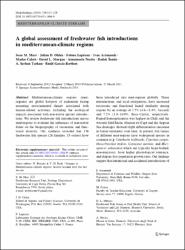| dc.contributor.author | Marr, Sean M. | |
| dc.contributor.author | Olden, Julian D. | |
| dc.contributor.author | Leprieur, Fabien | |
| dc.contributor.author | Arismendi, Ivan | |
| dc.contributor.author | Caleta, Marko | |
| dc.contributor.author | Morgan, David L. | |
| dc.contributor.author | Garcia-Berthou, Emili | |
| dc.contributor.author | Tarkan, Ali Serhan | |
| dc.date.accessioned | 2020-11-20T16:19:15Z | |
| dc.date.available | 2020-11-20T16:19:15Z | |
| dc.date.issued | 2013 | |
| dc.identifier.issn | 0018-8158 | |
| dc.identifier.issn | 1573-5117 | |
| dc.identifier.uri | https://doi.org/10.1007/s10750-013-1486-9 | |
| dc.identifier.uri | https://hdl.handle.net/20.500.12809/3720 | |
| dc.description | 0000-0001-8628-0514 | en_US |
| dc.description | WOS: 000325182400014 | en_US |
| dc.description.abstract | Mediterranean-climate regions (med-regions) are global hotspots of endemism facing mounting environmental threats associated with human-related activities, including the ecological impacts associated with non-native species introductions. We review freshwater fish introductions across med-regions to evaluate the influences of non-native fishes on the biogeography of taxonomic and functional diversity. Our synthesis revealed that 136 freshwater fish species (26 families, 13 orders) have been introduced into med-regions globally. These introductions, and local extirpations, have increased taxonomic and functional faunal similarity among regions by an average of 7.5% (4.6-11.4%; Jaccard) and 7.2% (1.4-14.0%; Bray-Curtis), respectively. Faunal homogenisation was highest in Chile and the western Med Basin, whereas sw Cape and the Aegean Sea drainages showed slight differentiation (decrease in faunal similarity) over time. At present, fish faunas of different med-regions have widespread species in common (e.g. Gambusia holbrooki, Cyprinus carpio, Oncorhynchus mykiss, Carassius auratus, and Micropterus salmoides) which are typically large-bodied, non-migratory, have higher physiological tolerance, and display fast population growth rates. Our findings suggest that intentional and accidental introductions of freshwater fish have dissolved dispersal barriers and significantly changed the present-day biogeography of med-regions across the globe. Conservation challenges in med-regions include understanding the ecosystem consequences of non-native species introductions at macro-ecological scales. | en_US |
| dc.description.sponsorship | DST/NRF Centre of Excellence for Invasion BiologyDepartment of Science & Technology (India); David and Elaine Potter Foundation; Spanish Ministry of ScienceSpanish Government [CGL2009-12877-C02-01, Consolider-Ingenio 2010 CSD2009-00065]; Czech Ministry of Culture [DKRVO2012, DKRVO 2013/14, 00023272]; Czech Ministry of Culture (National Museum) | en_US |
| dc.description.sponsorship | SMM acknowledges the financial support of the DST/NRF Centre of Excellence for Invasion Biology and the David and Elaine Potter Foundation during his PhD studies. EGB acknowledges funding support from the Spanish Ministry of Science (projects CGL2009-12877-C02-01 and Consolider-Ingenio 2010 CSD2009-00065). DLM acknowledges Dr Stephen Beatty (Murdoch University) for his work on the fishes of south-western Australia. RS. acknowledges support from the Czech Ministry of Culture (DKRVO2012 and DKRVO 2013/14, National Museum, 00023272). The authors thank Nicolas Poulet (ONEMA) for providing data on French Mediterranean river systems, Meta Povz and Predag Simonovic for providing data on Adriatic river systems, and Sergio Zerunian and Massimo Lorenzoni for providing data on Italian river systems. | en_US |
| dc.item-language.iso | eng | en_US |
| dc.publisher | Springer | en_US |
| dc.item-rights | info:eu-repo/semantics/openAccess | en_US |
| dc.subject | Introduced Species | en_US |
| dc.subject | Non-Native Species | en_US |
| dc.subject | Conservation Biogeography | en_US |
| dc.subject | Taxonomic Homogenisation | en_US |
| dc.subject | Functional Homogenisation | en_US |
| dc.title | A global assessment of freshwater fish introductions in mediterranean-climate regions | en_US |
| dc.item-type | article | en_US |
| dc.contributor.department | MÜ, Su Ürünleri Fakültesi, Su Ürünleri Temel Bilimleri Bölümü | en_US |
| dc.contributor.institutionauthor | Tarkan, Ali Serhan | |
| dc.identifier.doi | 10.1007/s10750-013-1486-9 | |
| dc.identifier.volume | 719 | en_US |
| dc.identifier.issue | 1 | en_US |
| dc.identifier.startpage | 317 | en_US |
| dc.identifier.endpage | 329 | en_US |
| dc.relation.journal | Hydrobiologia | en_US |
| dc.relation.publicationcategory | Makale - Uluslararası Hakemli Dergi - Kurum Öğretim Elemanı | en_US |


















